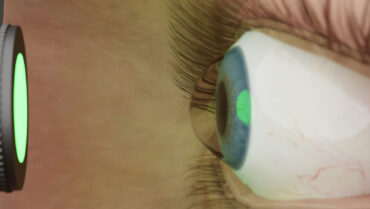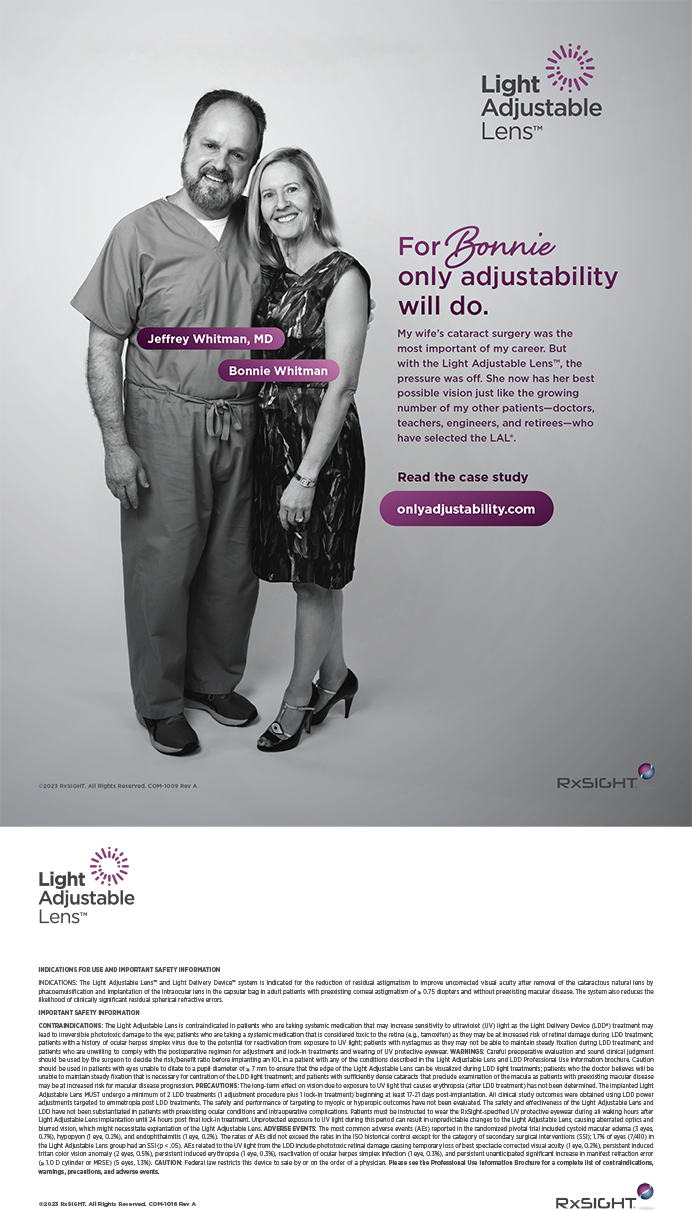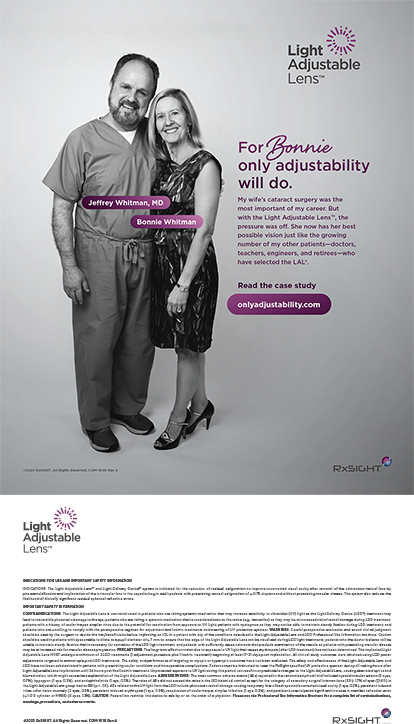

Comparison of Long-Term Outcomes of Simultaneous Accelerated Corneal Cross-Linking Combined With Intracorneal Ring Segment or Topography-Guided Photorefractive Keratectomy
Cohen E, Tone SO, Mimouni M, et al1
Industry support: None
ABSTRACT SUMMARY
A prospective, nonrandomized, interventional study compared the long-term outcomes of simultaneous accelerated CXL combined with either intrastromal corneal ring segments (CXL-ICRS) or topography-guided PRK (CXL-TG-PRK) in eyes that had progressive keratoconus. The research builds upon an earlier study with 1 year of follow-up by the same group.2 Of the original 248 eyes, 57 (CXL-ICRS, n = 32; CXL-TG-PRK, n = 25) were included. The mean follow-up duration was 51.28 months for the CXL-ICRS group and 54.57 months for the CXL-TG-PRK group.
Study in Brief
A prospective, nonrandomized, interventional study compared the 5-year clinical outcomes of CXL with two adjunctive modalities—intrastromal corneal ring segments (ICRSs) and topography-guided PRK (TG-PRK)—for the treatment of progressive keratoconus.
Only patients in the CXL-ICRS group experienced an improvement in visual parameters. Both treatment groups achieved an improvement in topographic parameters, although the change was greater in the CXL-TG-PRK group. The improvement in topography remained stable over the long term in the CXL-ICRS group but regressed in the CXL-TG-PRK group. Safety was excellent in both groups.
WHY IT MATTERS
The study offers insight into the long-term efficacy of ICRS implantation and TG-PRK when these procedures are combined with CXL for the visual rehabilitation of patients with keratoconus.
At the final follow-up visit, the change (improvement) in patients’ logMAR uncorrected distance visual acuity (UDVA) compared to preoperative values was significant in the CXL-ICRS group (-0.31 ±0.27, P < .001; equivalent to approximately 3 lines) but not the CXL-TG-PRK group (-0.06 ±0.42, P = .43; < 1 line). Patients’ logMAR corrected distance visual acuity (CDVA) improved significantly after CXL-ICRS (-0.22 ±0.20, P < .001) but not after CXL-TG-PRK (-0.05 ±0.22, P = .25). The manifest refractive spherical equivalent changed in the CXL-ICRS group by a mean of -2.03 D (±4.76) but remained unchanged in the CXL-TG-PRK group (-0.05 D [±4.94]). The adjusted mean difference was not significant.
Mean refractive cylinder improved in both groups from baseline to the last follow-up visit: -0.71 D (±2.84) and -0.95 D (±2.19) in the CXL-ICRS and CXL-TG-PRK groups, respectively. Again, however, the adjusted mean difference in change was not significant. The mean maximum keratometry value (Kmax) changed significantly for both groups from baseline to the last follow-up visit, with a mean improvement of -2.81 D ±4.73 and -2.69 D ±3.12 in the CXL-ICRS and CXL-TG-PRK groups, respectively. The mean Kmax value from 1 year postoperatively to the final follow-up visit steepened by a mean of 1.31 D in the CXL-TG-PRK group. Four eyes in each group experienced Kmax steepening (≥ 1.00 D); two eyes in each group experienced greater than a 2.00 D increase. All eyes achieved 20/50 BCVA or better.
DISCUSSION
Patients who underwent CXL-ICRS experienced significant improvements in their UDVA, CDVA, manifest refractive spherical equivalent, Kmax, and coma. Those treated with CXL-TG-PRK experienced a significant improvement only in refractive cylinder, Kmax, and coma. Other long-term studies of CXL-TG-PRK have reported a much more significant improvement in patients’ UDVA and CDVA.3-5 These studies, however, also sought some correction of the spherocylindrical component instead of focusing solely on higher-order aberrations, as in the research by Cohen et al.1
The insertion of two ICRSs appears to increase efficacy, as shown by Saleem et al.6 ICRS implantation alone has been found to be less effective7 than when the procedure is performed in combination with CXL, suggesting that pairing ICRS implantation with CXL may have a synergistic effect on long-term visual outcomes. Long-term stability in both groups (CXL-ICRS and CXL-TG-PRK) seemed to be greater than 80%.1
Asymmetric All-Femtosecond Laser-Cut Corneal Allogenic Intrastromal Ring Segments
Bteich Y, Assaf JF, Gendy JE, et al8
Industry support: None
ABSTRACT SUMMARY
Keratoconus management involves regularizing the corneal surface to address the irregular astigmatism and higher-order aberrations characteristic of the disease. Corneal allogenic intrastromal ring segments (CAIRS) and ICRSs are widely used and are an alternative to corneal transplantation for patients who have clear corneas.9 The manual technique for harvesting CAIRS produces segments with a unique depth (500 and 750 µm). These are not helpful for eyes that have asymmetric cones, as occurs with type 2 keratoconus (also known as the Duck phenotype), where the axes of astigmatism and coma do not coincide.
Study in Brief
A study describes a novel technique for cutting asymmetric corneal allogenic intrastromal ring segments with a femtosecond laser. These were used as a customizable alternative to synthetic PMMA segments of a fixed size for the treatment of keratoconus.
WHY IT MATTERS
The manual harvesting technique creates allogenic segments that are unsuitable for eyes with asymmetric cones, such as those with type 2 keratoconus (also known as the Duck phenotype), where the axes of astigmatism and coma do not coincide. The laser-assisted technique described in this study was designed specifically for these eyes.
To treat type 2 keratoconus, Bteich and colleagues developed a technique in which a Femto LDV Z8 laser (Ziemer Ophthalmic Systems) was used to harvest asymmetric CAIRS. After debridement of the donor corneal epithelium and endothelium, the donor cornea was mounted on an artificial anterior chamber, and the CAIRS were automatically harvested with pulsed femtosecond laser energy (10–20 nJ) at a frequency of 10 to 20 MHz. The thickness of the excised allogenic segments varied from the Bowman layer side to the stromal side and ranged from 500 to 750 μm. The CAIRS were then dehydrated in an atmosphere of 35% to 45% average humidity.
Tunnels were created in the host cornea under topical anesthesia with the femtosecond laser system’s standard ICRS software.10 The tunnels had a width of 900 μm, an inner diameter of 6 mm, and an outer diameter of 7.8 mm, with two diametrically opposite incisions according to the intended position of the implantation.
A dehydrated CAIRS was positioned in a tunnel at a 6-mm optical zone such that the Bowman layer side was perpendicular to the corneal surface.
Patients’ spherical and cylindrical refractive errors decreased from -2.38 D ±2.96 and -2.94 D ±2.16 at baseline to -1.81 D ±2.77 (P = .04) and -1.75 D ±2.07 (P = .01), respectively, at 6 months postoperatively. Kmax decreased from 50.02 D ±1.99 to 47.89 D ±3.05 (P = .03), and coma was reduced from 1.05 D ±0.21 to 0.21 D ±0.19 (P = .01). On average, patients’ CDVA improved by 3 lines.
Cutting 360º arcs in donor corneal tissue allowed the investigators to harvest precise, customizable CAIRS. The technique effectively reduced coma and astigmatism in the four studied cases with noncoinciding astigmatism and coma axes.
DISCUSSION
Because of the novelty of creating asymmetric CAIRS with a femtosecond laser for the management of type 2 keratoconus, validated nomograms are lacking. Provided that further research makes the technique more repeatable and reproducible, it may be adopted by surgeons who have access to a femtosecond laser platform and eye banks, which could prepare CAIRS in advance. The ability to harvest many CAIRS from a single otherwise unused donor cornea, moreover, could increase patient access to keratoconus care worldwide.
1. Cohen E, Tone SO, Mimouni M, et al. Comparison of long-term outcomes of simultaneous accelerated corneal cross-linking combined with intracorneal ring segment or topography-guided photorefractive keratectomy. J Cataract Refract Surg. Published online November 27, 2023. doi:10.1097/j.jcrs.0000000000001369
2. Singal N, Ong Tone S, Stein R, et al. Comparison of accelerated CXL alone, accelerated CXL-ICRS, and accelerated CXL-TG-PRK in progressive keratoconus and other corneal ectasias. J Cataract Refract Surg. 2020;46(2):276-286.
3. Kanellopoulos AJ. Ten-year outcomes of progressive keratoconus management with the Athens protocol (topography-guided partial-refraction PRK combined with CXL). J Refract Surg. 2019;35(8):478-483.
4. Kontadakis GA, Kankariya VP, Tsoulnaras K, Pallikaris AI, Plaka A, Kymionis GD. Long-term comparison of simultaneous topography-guided photorefractive keratectomy followed by corneal cross-linking versus corneal cross-linking alone. Ophthalmology. 2016;123(5):974-983.
5. Kaiserman I, Mimouni M, Rabina G. Epithelial photorefractive keratectomy and corneal cross-linking for keratoconus: The Tel-Aviv protocol. J Refract Surg. 2019;35(6):377-382.
6. Saleem MIH, Ibrahim Elzembely HA, AboZaid MA, et al. Three-year outcomes of cross-linking plus (combined cross-linking with femtosecond laser intracorneal ring segments implantation) for management of keratoconus. J Ophthalmol. 2018;2018:6907573.
7. Kang MJ, Byun YS, Yoo YS, Whang WJ, Joo CK. Long-term outcome of intrastromal corneal ring segments in keratoconus: five-year follow up. Sci Rep. 2019;9(1):315.
8. Bteich Y, Assaf JF, Gendy JE, et al. Asymmetric all-femtosecond laser-cut corneal allogenic intrastromal ring segments. J Refract Surg. 2023;39(12):856-862.
9. Jacob S, Patel SR, Agarwal A, Ramalingam A, Saijimol AI, Raj JM. Corneal allogenic intrastromal ring segments (CAIRS) combined with corneal cross-linking for keratoconus. J Refract Surg. 2018;34(5):296-303.
10. Awwad ST, Jacob S, Assaf JF, Bteich Y. Extended dehydration of corneal allogenic intrastromal ring segments to facilitate insertion: the corneal jerky technique. Cornea. 2023;42(11):1461-1464




